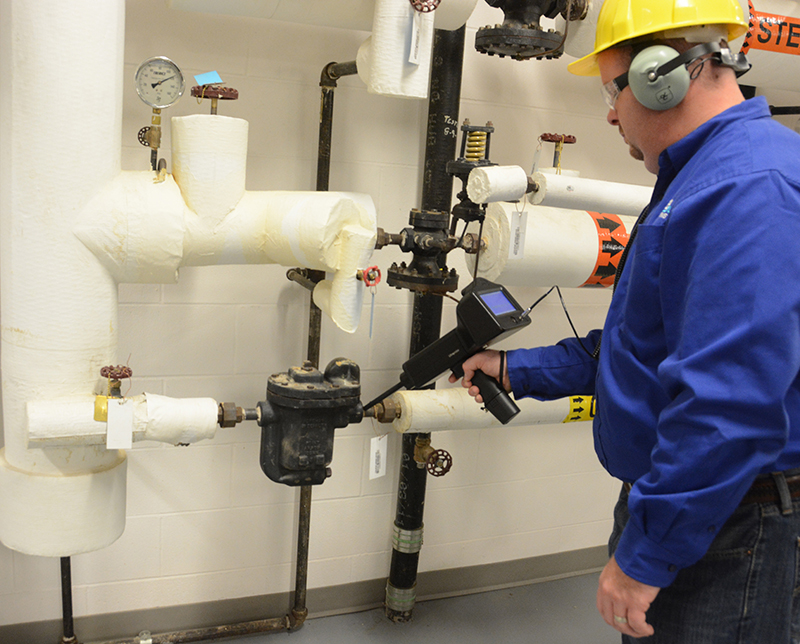Ultrasound Analysis (UA) is a predictive maintenance (PdM) tool that uses sound to identify potentially failing assets.
Overview
Ultrasound analysis can be used for leak detection, mechanical inspection, electrical Inspection, electric arc flash detection, steam trap maintenance, and valve testing.
UA has the advantage of lower acquisition costs and ease of use. Equipment and software costs are low compared to other PdM technologies. Ease of use is another feature of UA. You can hear the signal after some quick training.
How ultrasound analysis instruments work
UA instruments take high-frequency sounds picked up by a sensitive microphone and convert them into audio and digital data that can be heard and used by humans and software. They can be used on a case-by-case basis or on a fixed frequency to collect data over a period of time.
PdM uses current measurements and applies them to known issues or past measurements. Change from these helps detect potential problems.
UA data collected for PdM is usually collected on what is called a “route.” The route establishes what equipment is to be tested and where on the asset a reading should be made.
Portable UA sensors can collect data for immediate use or for uploading to a database for further analysis and performance tracking. Some units even have onboard thermometers, cameras, and spectral analyzers. They collect this data from sounds collected in the free air or with probes in contact with the component being tested.
Use cases for ultrasound analysis
Steam
A significant use case of UA deals with the inspection and service of steam systems. Failed steam systems are estimated to cost companies billions of dollars every year in wasted energy, lost production, and even damage to the environment.
Inefficient steam systems cause wasted dollars generating steam as well as making up for the losses. The US Department of Energy (DOE) says that even the smallest steam traps waste $8,000 in costs when failed.
Many people do not know about the role of steam in reducing harmful emissions in the environment. Failed systems expose companies to potential fines and loss of good public opinion. The DOE also estimates that even systems that are only three to five years old lose 15% to 35% of energy if not maintained properly.
Steam that is unreliable can also have a negative impact on life and product safety. A fatal 2017 explosion in Grand Central Station in New York City was attributed to poor steam management. Production operators who do not have quality steam control can also produce poor quality products in addition to the wasted cost of steam production.

An ultrasonic test of a steam trap. Image courtesy of UE Systems.
Compressed Air
Another type of energy loss is compressed air. Compressed air is expensive to generate. Costs for compressed air generation ranges from 30 cents to 50 cents for every 1,000 cubic feet.
It would seem obvious that a person could hear air leaks, but it is not as simple as that. Most facilities require the use of hearing protection and with the probable noisy environment, the loss of air is difficult to detect without assistance. It estimated that even a hole 1/6” in diameter will cost a company $523 per year.
Another advantage of UA for compressed air is its ability to quickly detect the precise location of air leaks. Their portable construction and the ability to use free air to pick up sounds allows UA instruments and their users to cover a large area in a short amount of time while troubleshooting.
Electrical Testing
UA detectors’ ability to obtain data from free air makes it a good tool for electrical testing. Faults that can be detected include acing, tracking, and corona. These situations produce high-frequency sounds that can be detected by UA systems.
The power of UA allows testing to be conducted from a safe distance. It can also reduce the need to get close to electrical equipment. Technicians can remain on the ground or a safe distance away to check equipment.
Testing can also be conducted with the use of a probe touching the outside of switchgear or electrical boxes to prevent potential exposure to the harmful effects of arc flash.
Mechanical Inspection
UA equipment can be used to monitor the performance of mechanical equipment. It does this by detecting the change in volume and frequency of mechanical components.
Elements of equipment such as bearings emit sounds that UA equipment can detect and measure. One of the uses of UA can be found in servicing bearings requiring lubrication. Technicians can listen to bearings as lubrication is applied. They are trained to apply the proper amount of lubrication through sound.
For example, a motor repair shop once reported that a failed 250 HP motor was brought in for repair. The motor was found to be packed with grease. Inquiries discovered that a technician incorrectly thought that a motor bearing should receive one pump for every horsepower of a motor. Clearly, UA would have prevented the failure in addition to providing good information to the technician.
Conclusion
UA is a powerful tool that maintenance teams can acquire at a reasonable cost and use with minimal training. The uses of UA are varied and offer substantial savings in detecting energy loss, failing systems, and completing assigned tasks safely.

![[Review Badge] Gartner Peer Insights (Dark)](https://www.datocms-assets.com/38028/1673900494-gartner-logo-dark.png?auto=compress&fm=webp&w=336)
